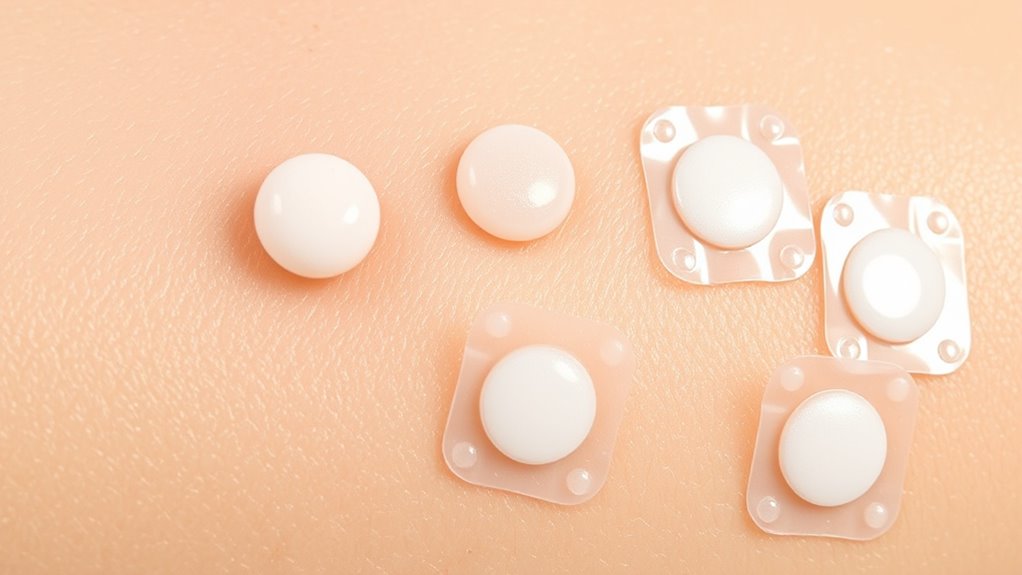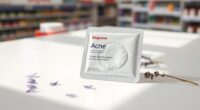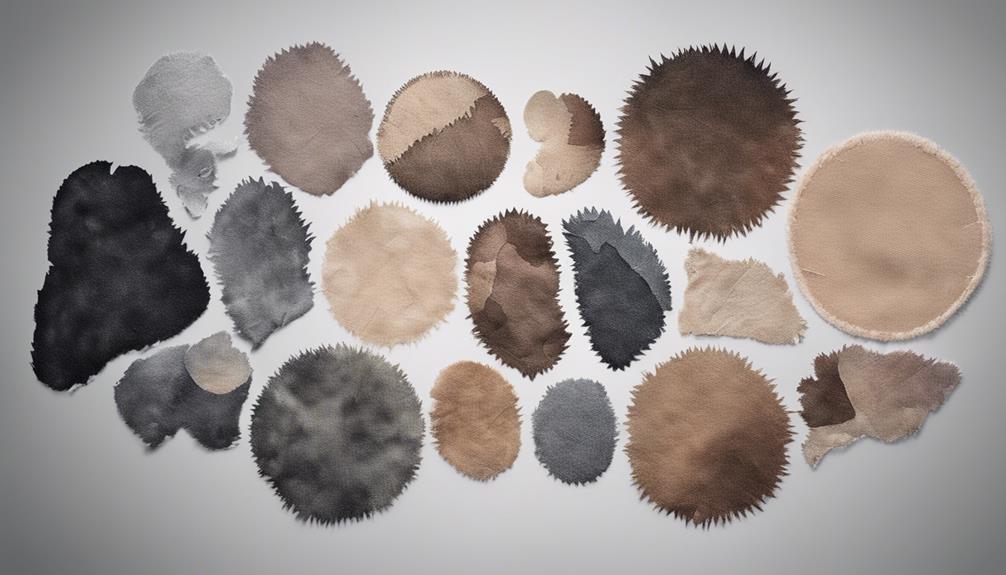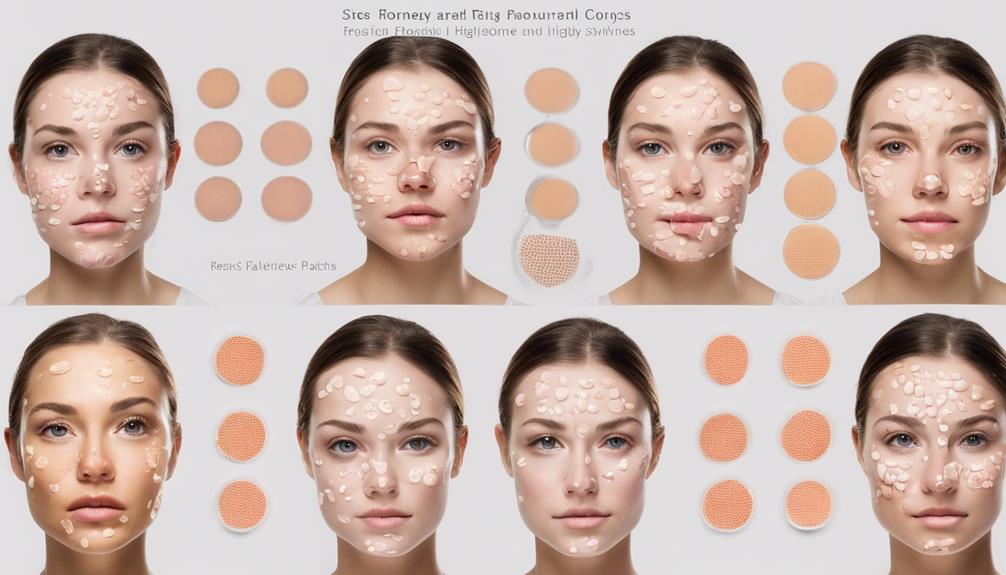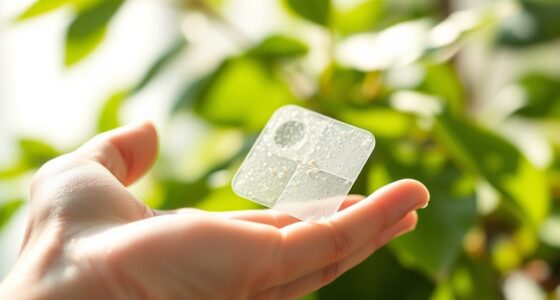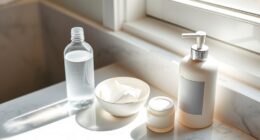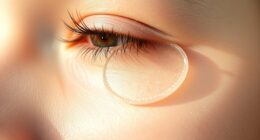Hydrocolloid patches are versatile tools beyond acne care. They can speed up wound healing by creating a moist environment and protecting against infection. These patches also cushion and protect blisters from friction, helping them heal faster. Post-surgical, they minimize scars and reduce irritation, promoting smoother recovery. Plus, they keep minor skin irritations clean and bacteria-free. Want to discover more innovative ways to use these handy patches? Keep exploring to reveal their full potential.
Key Takeaways
- Accelerate healing of minor cuts, scrapes, and blisters by creating a moist, protective environment.
- Reduce scarring and inflammation on post-surgical wounds with consistent coverage.
- Cushion and protect blisters caused by footwear or friction, preventing infection and irritation.
- Absorb excess oil and pus from pimples, minimizing redness, swelling, and scarring.
- Serve as a discreet, breathable barrier for skin irritations or minor injuries during daily activities.

Hydrocolloid patches are best known for their ability to heal pimples quickly, but their benefits extend far beyond acne care. You might be surprised to discover that these small, transparent stickers are versatile tools in your skincare and health arsenal, especially when it comes to acne treatment and wound healing. Originally designed to draw out impurities and reduce inflammation in pimples, hydrocolloid patches also create a protective barrier over minor cuts, scrapes, and blisters, promoting faster healing and preventing infection. When applied to a wound, they help maintain a moist environment, which research shows accelerates tissue repair and reduces scarring. This dual function makes them an excellent choice for anyone looking for simple, effective wound care solutions. Moist environment is a crucial factor in tissue regeneration and healing efficiency.
Hydrocolloid patches heal pimples and minor wounds by protecting, absorbing, and promoting faster recovery.
Using hydrocolloid patches for acne treatment is straightforward. When you notice a pimple forming, placing a patch over it can absorb excess oil and pus, reducing swelling and redness. Over time, this can shorten the lifespan of a breakout and minimize the chance of scarring. The patch acts as a shield, preventing you from picking at the blemish, which is vital for proper healing. Beyond that, they help keep the area clean and free from bacteria, further supporting skin recovery. The transparency of these patches means you can wear them discreetly during the day or overnight, making them a convenient and unobtrusive part of your skincare routine.
But their utility doesn’t stop at acne. If you have small cuts or blisters, hydrocolloid patches can be a game-changer. When applied to a minor wound, they create an ideal environment for healing by maintaining moisture and protecting against dirt and bacteria. This reduces pain, prevents infection, and can considerably cut down recovery time. Plus, because they absorb exudate, they prevent the wound from becoming overly moist or infected. Hydrocolloid patches are especially helpful for blisters, whether from shoes or repetitive friction, as they cushion the area and promote quicker resolution.
In addition, these patches can be used on post-surgical sites or skin irritations, helping to minimize scarring and facilitate healing. Their adhesive quality ensures they stay in place, even during daily activities, and once removed, you often see less inflammation and a smoother recovery process. Whether dealing with acne, cuts, or blisters, hydrocolloid patches serve as a simple, effective solution that harnesses the power of wound healing and skin protection, making them an essential item for your first aid kit and skincare regimen.
Frequently Asked Questions
Can Hydrocolloid Patches Help With Scars or Hyperpigmentation?
You might wonder if hydrocolloid patches can help with scars or hyperpigmentation. While they’re great for scar fading by protecting wounds and promoting healing, they aren’t specifically designed for hyperpigmentation treatment. These patches can reduce redness and prevent infection, but for dark spots or hyperpigmentation, you’ll need targeted treatments like brightening serums or creams. Hydrocolloid patches are more effective for active breakouts and healing rather than fading scars or hyperpigmentation.
Are There Any Side Effects From Using Hydrocolloid Patches Daily?
Using hydrocolloid patches daily can sometimes cause skin irritation or allergic reactions, especially if you have sensitive skin. You might notice redness, itching, or discomfort after prolonged use. It’s important to monitor your skin’s response and avoid wearing patches overnight or for extended periods. If you experience persistent irritation or allergic reactions, discontinue use and consult a dermatologist to prevent further skin issues.
How Long Can Hydrocolloid Patches Be Safely Left on Skin?
They say a watched pot never boils, but with hydrocolloid patches, you should never leave them on indefinitely. For ideal duration safety, it’s best to follow product instructions—usually 8-12 hours—since patch longevity varies. Leaving a patch on too long can cause irritation or trap bacteria. Always remove the patch once it’s full of fluid or after the recommended time to keep your skin healthy and avoid adverse effects.
Do Hydrocolloid Patches Work on All Skin Types and Tones?
You might wonder if hydrocolloid patches work on all skin types and tones. Generally, they are suitable for most skin tones because they don’t leave pigment stains. However, skin type compatibility varies; those with sensitive or eczema-prone skin should test a small area first. These patches are effective across diverse skin tones, but individual reactions depend on your skin’s unique characteristics. Always check product labels for specific skin tone suitability.
Can Hydrocolloid Patches Be Used on Open Wounds or Cuts?
You might wonder if hydrocolloid patches are safe for open wounds or cuts. While they’re great for acne, using them on open wounds isn’t recommended due to open wound safety concerns. If you choose to use a patch, follow proper patch application guidelines—clean the wound thoroughly and make sure it’s dry. For open wounds, consult a healthcare professional before applying any patch to avoid infection or complications.
Conclusion
Now that you’ve uncovered these unexpected uses for hydrocolloid patches, think of them as your secret weapon—like a modern-day fairy godmother—ready to transform more than just pimples. With a little creativity, you can turn these patches into versatile allies for scars, insect bites, or even blisters. So, keep them close, and let your newfound knowledge work its magic, proving that sometimes, the most surprising solutions are just a patch away from turning your skincare routine into a true fairy tale.
